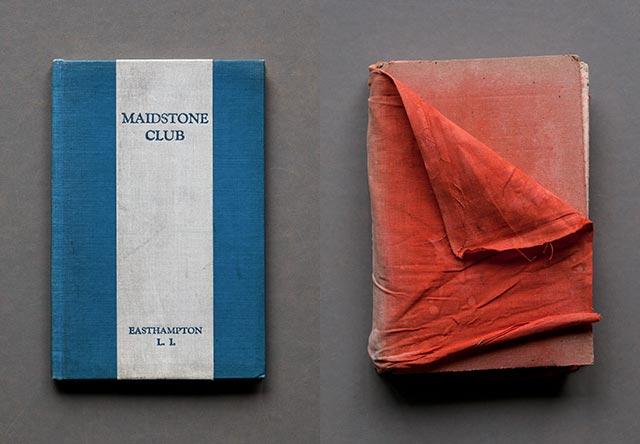The Spirit of Grey Gardens Captured in East Hampton

The intersection of Mary Ellen Bartley, known for her long engagement with the quiet formal qualities of books, and Grey Gardens, a continual source of curiosity and prurient interest, makes no sense in any obvious way. Yet, it has resulted in an unexpected and knockout exhibition at the Drawing Room gallery in East Hampton.Although the East Hampton property has been owned for decades by the Washington, D.C., media elites Sally Quinn and her late husband, Ben Bradlee, it is famous primarily as the former residence of Edith Ewing Bouvier Beale and Edie Bouvier Beale, the abandoned wife and daughter of Phelan Beale. The pair lived in abject conditions in what had been a well-appointed house in Georgica.The mother and daughter, known informally as Big Edie and Little Edie, became the subjects of the documentary “Grey Gardens,” by Albert and David Maysles. A fascinating and touching bit of cinéma vérité on its own, it gained traction and rocket fuel from the fact that these women were close relations to the former first lady of the United States, Jacqueline Bouvier Kennedy, who was still married to Aristotle Onassis, one of the richest men in the world, when the film came out in 1975.In the early ’70s, the Suffolk County Health Department threatened the women with eviction. The house had no running water and was filled with cats, wild animals, and garbage. By the time the filmmakers arrived, however, Grey Gardens had been brought up to code with funds from Mrs. Onassis and Lee Radziwill, her sister. Still, the documentary showed a house rife with decay.After they bought the house in 1979, Ms. Quinn and Mr. Bradlee fully restored it, and it is now for sale. They found the Beales’ books in a Dumpster and rescued them, according to the gallery. Ms. Bartley, who is based in Wainscott, received access to the books, and has created a body of work from the titles before they likely disappear from their original home.The books appear to have so taken Ms. Bartley that she has adapted her process to them. Traditionally she has been concerned with the object-ness of books, the way they stack, how the pages subtly reveal themselves when they are cracked open just so, how the bound cloth covers‚ often blue‚ look when placed together in a composition.There is some of that here, but many of the books come to us in a more traditional way, placed flat on a gray ground, cover up, embossed title exposed, looking much like specimens. The images she has posted on Instagram over the past several months give a false sense of familiarity. These look very little like the small, flat images there. The photos in person seem to breathe and rise off their plain backgrounds as if they are floating slightly above. It is imperative to see them this way to truly experience them.The grouping of these cover shots in the gallery is skillful and knowing. The titles, which can be witty and poignant, seem to echo certain repeating themes in the story of the women’s lives, which have been reimagined in recent years as a narrative film and as a stage musical.With the show’s title, “Reading Grey Gardens,” as a guide, the words Ms. Bartley captures either on the front, spines, or frontispieces, matter. Titles are part of the piece. “Cats,” by Ylla, near the very beginning of the show, establishes the tie, and an image of a book plate, “Ex Libris Edith Beale,” along with Little Edie’s signature, adds a personal touch.There are classics, such as “Mutiny on the Bounty” and “Frankenstein,” and a number of what would be categorized these days as self-help books: “Why Men Like Us,” “The Truth About Beauty,” “Look Younger, Live Longer,” and “Release From Nervous Tension” are some of them. Then there are the signifiers that these women, despite their later circumstances, came from one of the most prominent families in the area, such as “The Riding Club of East Hampton” and the membership rules of “The Maidstone Club.”Some book bindings are so damaged that no title is left on the covers, which are torn, abraded, or even rotting, with pits and discoloration. Yet the way they are photographed, they could be precious artifacts from a ship’s cargo left exposed to the elements, sea spray, and salt air.Further on in the gallery is evidence that Ms. Bartley maintains some formalist concerns with these volumes. “Flat Red Book” is precisely that, but “Memoirs of Barras” is a stack of three faded and cantilevered hardcovers. In “This Bright Summer,” she lines up the books by their spines, but the writing on most of them, except for the one used in the titles of the photo, is incomprehensible or torn. The faded spines offer a delightful, but also sad, irony.There are also a few book “Stacks,” which are like pretty macarons in their gently faded colors of pink, orange, green, and turquoise. This is the Bartley we know better, but the books still look different from what has come before. When she trained her lens on these volumes, she imbued them with consequence and dignity, transforming them from mere objects to relics, and she may have been transformed herself in the process.The exhibition remains on view through Oct. 15.
